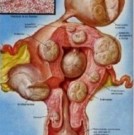ELIMINACION DE MIOMAS / TRATAMIENTO EN PUEBLA
Dado que la mayor parte de la sangre que llega al útero lo hace a partir de las arterias uterinas, se ha postulado que luego de la oclusión de dichas arterias se produciría una isquemia uterina transitoria. Esta hipótesis propone que inmediatamente después de la oclusión, la sangre que se encuentra en el miometrio se coagula, el miometrio se vuelve hipóxico y el metabolismo cambia de la vía oxidativa a la glucólisis anaeróbica. Horas después, se produce la lisis de los coágulos miometriales y el útero es reperfundido a partir de las arterias colaterales. Por su parte, un estudio señaló que la oclusión de las arterias uterinas genera necrosis de los miomas, pero no del miometrio. Este hecho contribuiría a reducir el tamaño tumoral. Miomectomia por laparoscopia

Por lo tanto, la principal ventaja de la ligadura de las arterias uterinas previa a la miomectomía consiste en la disminución de la pérdida de sangre durante el procedimiento. Como beneficio adicional, se produciría una reducción en el tamaño de pequeños miomas que no son extraídos durante el procedimiento quirúrgico, lo que ayudaría a prevenir la recurrencia de nuevos miomas.
La ligadura de las arterias uterinas por vía laparoscópica combinada con la miomectomía ha demostrado reducir exitosamente la pérdida de sangre durante la intervención. Las arterias uterinas pueden ser ligadas mediante un abordaje anterior o posterior, dependiendo de la localización del leiomioma. En el caso de miomas del segmento inferior o de miomas cervicales, la arteria uterina puede ser ligada en su origen, desde la división anterior de la ilíaca interna.
Se prefiere realizar la ligadura de la rama ascendente de la arteria uterina por medio del abordaje anterior. Este abordaje facilita la identificación de los vasos uterinos y previene la inclusión de los uréteres en la sutura. Una vez que se ocluyen las arterias uterinas en forma bilateral, el mioma se vuelve pálido o izquemico. A continuación, se abre la cápsula del mioma y se enuclea a lo largo del plano de clivaje, separando el mioma del miometrio circundante. Luego se oblitera el lecho vascular del tumor y se cierra la cápsula en uno o dos planos, dependiendo de su profundidad en la pared uterina. Por último, se retira el tumor a través de la puerta de entrada mediante la fragmentación de la pieza quirúrgica o mediante un morcelador laparoscopico.
En el caso de los miomas del segmento inferior o de los miomas cervicales, se ligan los vasos uterinos desde su origen en la división anterior de la ilíaca interna, previa identificación de los uréteres y su relación con la arteria uterina a fin de evitar su ligadura inadvertida. Luego de la sutura bilateral de las arterias uterinas, el mioma se vuelve pálido y es enucleado de su lecho. A continuación, se cierra la cápsula y se retira el mioma mediante la fragmentación de la pieza quirúrgica.
Otra ventaja de la ligadura de los vasos uterinos se observa en el caso de los miomas degenerativos, en donde la fragmentación se lleva a cabo mientras el tumor aún se encuentra unido a su lecho. En este caso, dado que el mioma se fragmenta antes de la enucleación, puede producirse un sangrado profuso. No obstante, el sangrado se previene mediante la ligadura bilateral de los vasos uterinos previamente a la miomectomía. Miomectomia en Puebla Experto en miomas tratamiento de los miomas
Por otra parte, la interrupción de la irrigación de los miomas mediante la ligadura selectiva de las arterias uterinas constituye la base de muchas modalidades terapéuticas que se utilizan para los miomas sintomáticos. Tal es el caso de la coagulación laparoscópica bipolar de las arterias uterinas o el de la embolización de las arterias uterinas. Los autores agregan que la ligadura de los vasos uterinos como primer paso para la histerectomía laparoscópica total reduce considerablemente la pérdida de sangre durante el procedimiento, sobre todo en el caso de miomas de gran tamaño.
La embolización de las arterias uterinas está indicada para el tratamiento de hemorragias uterinas importantes y para la reducción del volumen uterino. Una complicación asociada con esta técnica es el síndrome posembolización, que se caracteriza por fiebre, dolor, náuseas, vómitos y leucocitosis, y que afecta hasta al 26% de las pacientes. Por su parte, la oclusión de las arterias uterinas mediante coagulación bipolar por vía laparoscópica ha obtenido resultados similares a la técnica de embolización. De todos modos, se ha postulado que la oclusión de los vasos uterinos combinada con la miomectomía laparoscópica brinda mejores resultados que la sola oclusión vascular sin miomectomía.
Conclusión
La miomectomía laparoscópica con ligadura de las arterias uterinas es un procedimiento técnicamente viable. La ligadura bilateral de los vasos uterinos, ya sea en la rama ascendente o en su origen desde la ilíaca interna, reduce considerablemente la pérdida de sangre durante la miomectomía. Asimismo, esta técnica también reduce el tamaño de miomas pequeños que no son extirpados, lo que contribuye a prevenir las recurrencias.
Referencia:
Resumen objetivo elaborado por el Comité de Redacción Científica de SIIC en base al artículo original completo publicado por la fuente editorial.
Sociedad Iberoamericana de Información Científica (SIIC)
Laparoscopic myomectomy with ligation of arteries
Since most of the blood supply to the uterus does from the uterine artery , it has been postulated that after occlusion of these arteries occur onetransient uterine ischemia . This hypothesis proposes that immediately after occlusion, the blood is coagulated myometrium, myometrium becomes hypoxic and oxidative metabolism changes to anaerobic glycolysis pathway. Hours later, the myometrial clot lysis occurs and the uterus is reperfused from collateral arteries. Meanwhile, one study showed that occlusion of the uterine arteries produces necrosis of fibroids, but not the myometrium. This would help to reduce tumor size.
Therefore, the main advantage of the uterine artery ligation prior to myomectomy is decreased blood loss during the procedure. As a bonus, a reduction would occur in the size of small fibroids that were removed during the surgical procedure, which would help prevent recurrence of new fibroids. Prior to surgery, a luminal ultrasound with color Doppler is performed to locate the arteries.
Ligation of the uterine arteries via laparoscopy combined with myomectomy has successfully demonstrated to reduce blood loss during surgery.
The uterine arteries can be linked through an anterior or posterior approach, depending on the location of the leiomyoma. In the case of the lower segment fibroids or cervical fibroids, uterine artery can be ligated at its origin from the anterior division of the internal iliac. Myomectomy in Puebla
Is preferred to perform ligation of the ascending branch of the uterine artery through the anterior approach. This approach facilitates the identification of the uterine vessels and prevents the inclusion of the ureters in the suture. Once the uterine arteries are occluded bilaterally, the fibroid becomes pale. Next, the capsule opens and myoma enucleated along the cleavage plane, separating the surrounding myometrial fibroids.The tumor vascular bed is then obliterated and close the capsule in one or two planes, depending on their depth in the uterine wall. Finally, the tumor through the door by the fragmentation of the surgical specimen or a laparoscopic morcellator removed. Should if possible link utero ovarian arteries.
In the case of the lower segment fibroids or myomas cervical, the authors propose the uterine vessels link originated from the previous division of the internal iliac, prior identification of the ureters and its relation to the uterine artery to avoid inadvertent ligation. After the suture bilateral uterine arteries, becomes pale and myoma is enucleated from its bed. Then the capsule is closed and the fibroid is removed by the fragmentation of the surgical specimen.
Another advantage of the ligation of the uterine vessels are observed in the case of degenerative myomas, where the fragmentation is carried out while the tumor is still attached to its bed. In this case, since the fibroid was fragmented before enucleation, profuse bleeding may occur. However, the bleeding is prevented by bilateral ligation of the previously myomectomy uterine vessels.
Moreover, disruption of irrigation fibroids by selective uterine artery ligation is the basis of many therapeutic modalities used for symptomatic fibroids. Such is the case with laparoscopic bipolar coagulation of uterine arteries or embolization of the uterine arteries. The uterine vessel ligation as a first step for laparoscopic total hysterectomy significantly reduces blood loss during the procedure, especially in the case of large fibroids.
The uterine artery embolization is indicated for the treatment of major uterine bleeding and uterine volume reduction. A complication associated with this technique is the embolization syndrome, characterized by fever, pain, nausea, vomiting and leukocytosis affecting up to 26% of patients. Meanwhile, occlusion of uterine arteries using bipolar coagulation laparoscopically obtained similar results embolization technique.Anyway, it has been postulated that occlusion of uterine vessels combined with laparoscopic myomectomy provides better results than single vascular occlusion without myomectomy.
Conclusion
The laparoscopic myomectomy with uterine artery ligation is a technically feasible procedure. The bilateral ligation of the uterine vessels, either upstream or originally from the internal iliac, significantly reduces blood loss during myomectomy. Furthermore, this technique also reduces the size of small fibroids that are not removed, which helps prevent recurrences.
Reference:
Target Summary prepared by the Committee on Scientific Writing SIIC
based on the full original article published by source.
Iberoamerican Society of Scientific Information (SIIC)
Die laparoskopische myomectomy mit Unterbindung der Arterien
Da die meisten der Blutversorgung des Uterus macht von der Gebärmutterarterie , es wurde postuliert, dass nach der Okklusion dieser Arterien auftreten, eine transiente Ischämie Uterus . Diese Hypothese schlägt vor, dass unmittelbar nach der Okklusion, ist das Blut koagulierte Myometrium, Myometrium wird hypoxische und oxidativen Stoffwechsel Änderungen an der anaeroben Glykolyse Weg. Stunden später, tritt der myometrische Gerinnsel-Lyse und die Gebärmutter von Kollateralarterien reperfundiert. Unterdessen zeigte eine Studie, dass die Okklusion der Gebärmutterarterien produziert Nekrose von Myomen, aber nicht das Myometrium. Dies würde helfen, die Tumorgröße zu reduzieren.
Daher besteht der Hauptvorteil der Gebärmutterarterie Ligation wird vor myomectomy Blutverlust während des Verfahrens verringert. Als Bonus, würde eine Verringerung der Größe der kleinen Myomen, die während des chirurgischen Verfahrens, das helfen würde, eine Wiederholung zu vermeiden neuer Myome entfernt wurden, auftreten. Vor der Operation wird ein Lumen mit Farb-Doppler-Ultraschall durchgeführt, um die Arterien zu lokalisieren.
Ligation der Gebärmutterarterien über Laparoskopie kombiniert mit myomectomy hat erfolgreich gezeigt, um den Blutverlust während der Operation zu reduzieren.
Gebärmutterarterien durch einen vorderen oder hinteren Zugang verbunden werden, abhängig von der Lage des Leiomyom. Im Fall der unteren Segment Myomen oder zervikale Myome, Gebärmutterarterien kann an ihrem Ursprung aus der vorderen Spaltung des Binnenbecken ligiert werden. Myomectomy in Puebla
Wird bevorzugt, um die Ligation des aufsteigenden Ast der Gebärmutterarterie durch die vordere Ansatz durchzuführen. Dieser Ansatz erleichtert die Identifizierung der Gebärmuttergefäße und verhindert die Aufnahme der Harnleiter in der Naht. Sobald die Gebärmutterarterien bilateral verschlossen wird, wird das Myom blass. Als nächstes öffnet sich die Kapsel und Myom entlang der Spaltebene ausgeschält, die Trennung der umgebenden Myometrium Myomen. Das Tumorgefäßbett wird dann ausgelöscht, und die Kapsel wird in einer oder zwei Ebenen, je nach ihrer Tiefe in der Uteruswand. Schließlich wird der Tumor durch die Tür, durch die Fragmentierung der chirurgischen Probe oder einer laparoskopischen Morcellator entfernt. Sollte wenn möglich Link utero Eierstock Arterien.
Im Fall der unteren Segment Myome oder Myome Gebärmutterhalskrebs, schlagen die Autoren die Uterusgefäße Link stammt aus dem vorherigen Spaltung des Binnenbecken vor Identifizierung der Harnleiter und seine Beziehung zu der Gebärmutterarterie zu vermeiden unbeabsichtigten Ligation. Nach den Naht bilateralen Gebärmutterarterien, wird blass und Myom wird aus sein Bett ausgeschält. Dann wird die Kapsel geschlossen und das Myom wird durch die Fragmentierung der Gewebeprobe entnommen.
Ein weiterer Vorteil der Ligation der Uterusgefäße werden im Fall von degenerativen Myome, wobei die Fragmentierung durchgeführt wird, während der Tumor noch in sein Bett befestigt beobachtet. In diesem Fall, da das Myom wurde vor der Enukleation fragmentiert, können starke Blutungen auftreten. Jedoch ist die Blutung durch bilaterale Ligation der zuvor myomectomy Uteringefäße verhindert.
Darüber hinaus ist Störung der Bewässerung Myomen durch selektive Gebärmutterarterie Ligation die Grundlage für viele therapeutische Modalitäten zur symptomatischen Myomen eingesetzt. Dies ist der Fall mit der laparoskopischen bipolaren Koagulation oder Gebärmutterarterien-Embolisation der Gebärmutterarterien. Die Uterusgefäßligation in einem ersten Schritt für die laparoskopische Hysterektomie Blutverlust erheblich reduziert während des Verfahrens, insbesondere im Fall von großen Myomen.
Die Gebärmutterarterienembolisation ist für die Behandlung von großen Gebärmutterblutung und Gebärmuttervolumenreduktion gekennzeichnet. Eine Komplikation, die mit dieser Technik verbunden ist, ist die Embolisation Syndrom, gekennzeichnet durch Fieber, Schmerzen, Übelkeit, Erbrechen und Leukozytose betrifft bis zu 26% der Patienten. Inzwischen Verschluss der Gebärmutterarterien mit bipolaren Koagulation laparoskopisch ähnliche Ergebnisse erhalten Embolisation Technik. Wie auch immer, es wurde postuliert, dass Okklusion der Gebärmuttergefäße kombiniert mit der laparoskopischen myomectomy liefert bessere Ergebnisse als Einzelgefäßverschluss ohne myomectomy.
Abschluss
Die laparoskopische myomectomy mit Uterusarterie Ligation ist ein Verfahren technisch machbar. Das bilaterale Ligation der Gebärmuttergefäße, entweder vor-oder ursprünglich aus dem inneren Becken, Blutverlust deutlich reduziert während myomectomy. Darüber hinaus ist diese Technik verringert auch die Größe von kleinen Myomen, die nicht entfernt werden, die Rückfälle zu verhindern hilft.
Referenz:
Zielübersicht durch den Ausschuss für Scientific Writing SIIC vorbereitet
auf der Grundlage der vollständigen Originalartikel von der Quelle veröffentlicht.
Iberoamerikanischen Gesellschaft für Wissenschaftliche Information (SIIC)
|



























